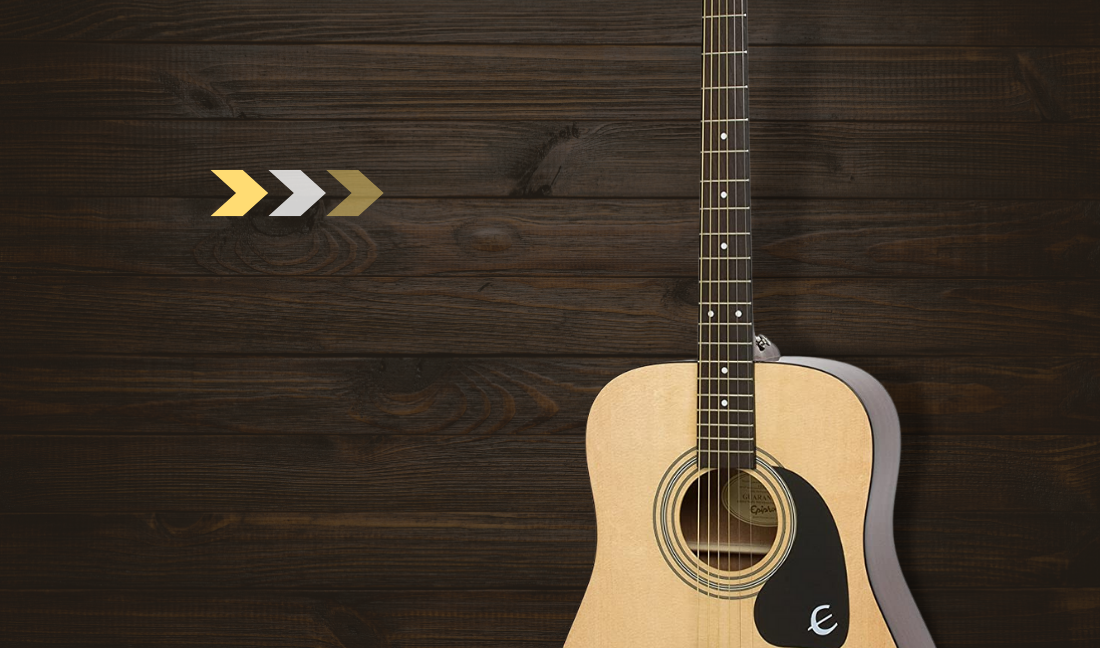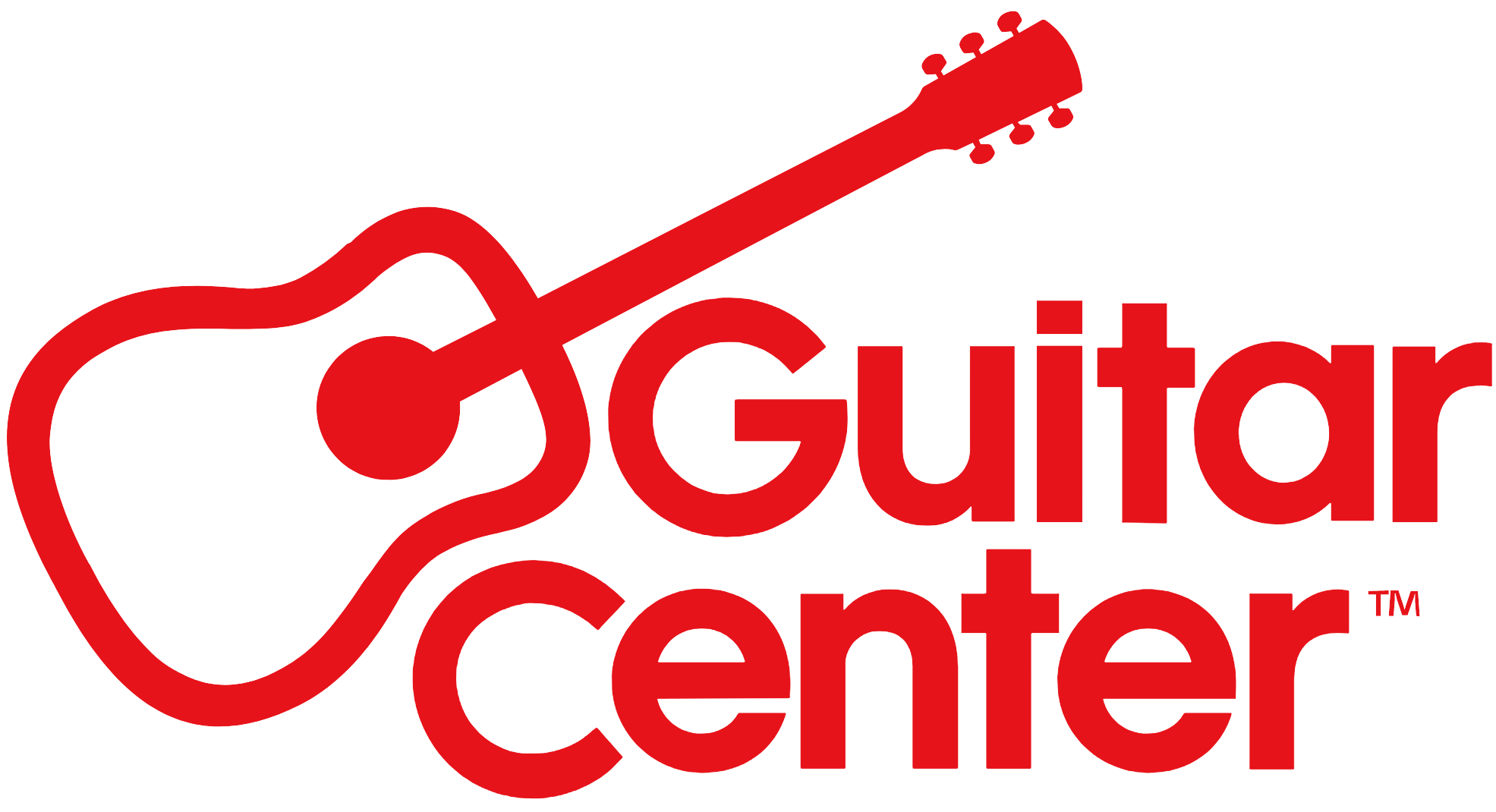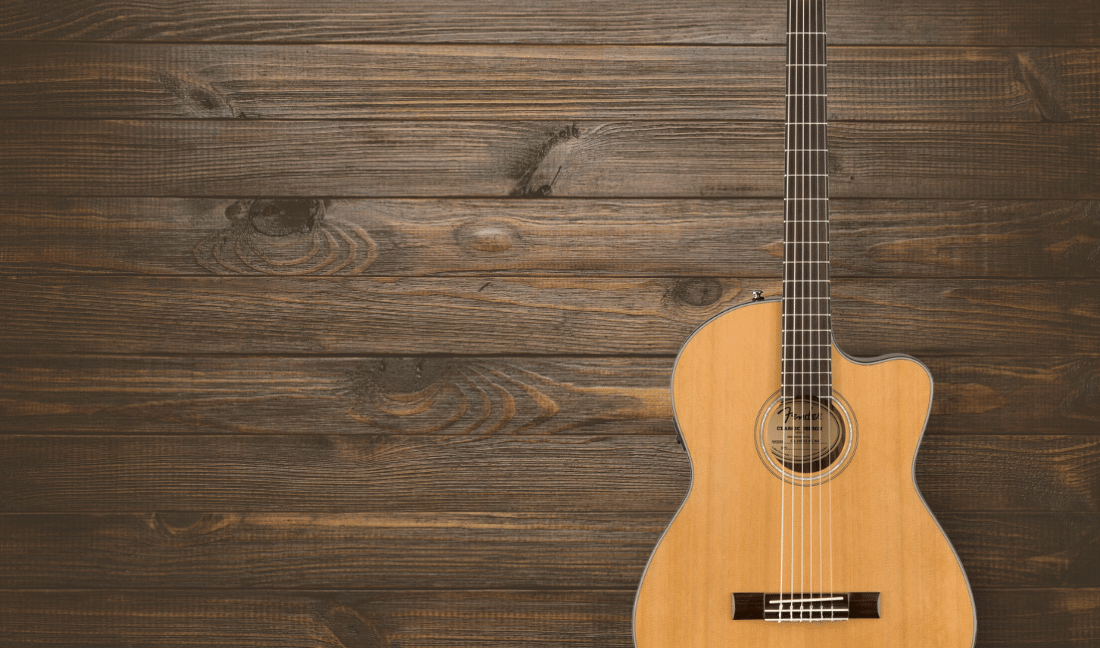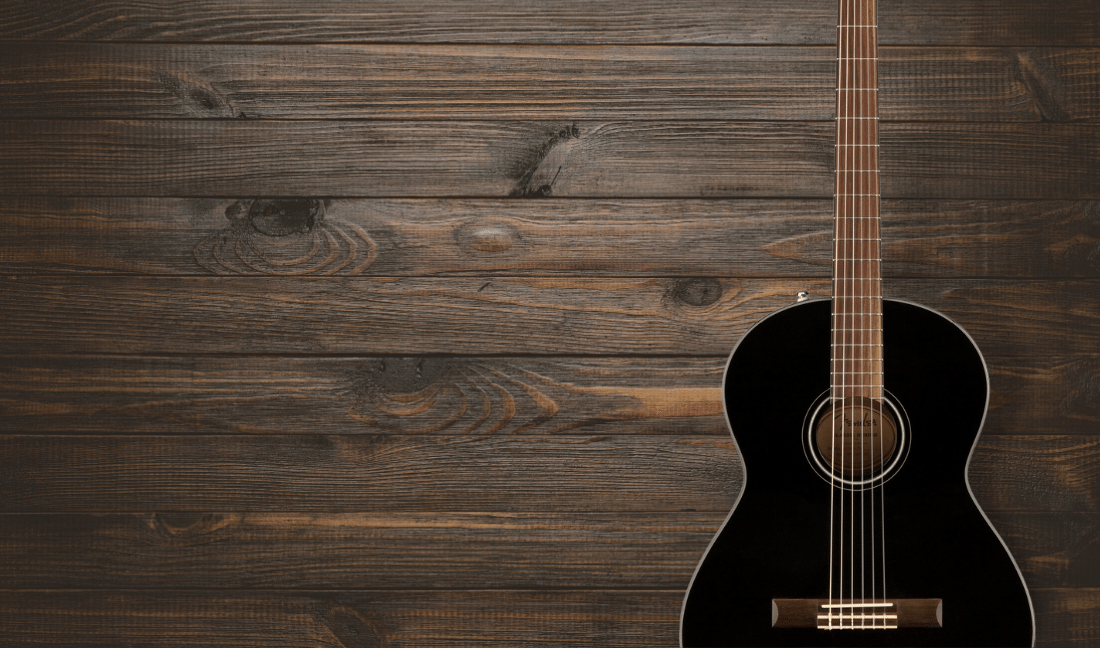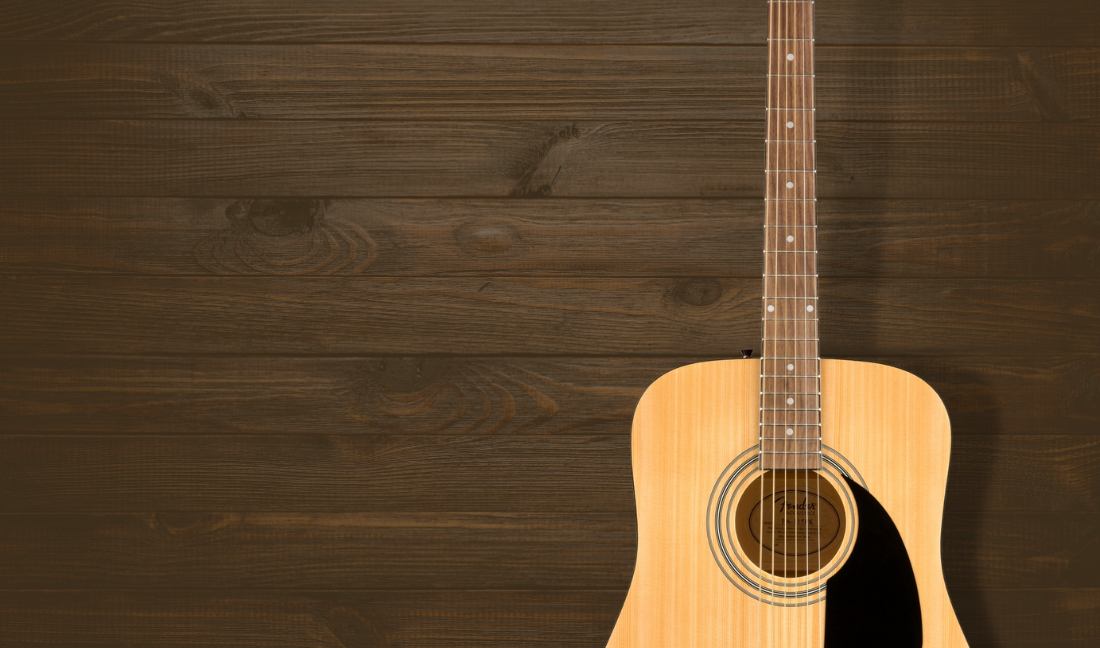The Epiphone DR-100 is an acoustic guitar that has been a popular choice for players of all levels for many years.
Its dreadnought body style is one of the most popular and versatile shapes, making it a great choice for any player.
You can purchase this guitar in many different stores, some of them include:
We may earn commissions from these links at no additional cost to you
The DR-100 features a spruce top with mahogany back and sides, and a rosewood fingerboard; it also has a warm, rich sound that is perfect for any style of playing.
In this review post, we’ll take an in-depth look at the Epiphone DR-100, examining its features, sound, and playability.
We’ll also help you understand what each of these features means, and how they affect the overall sound and playability of the guitar.
Table of Contents
Summary
Here’s our summary of the Epiphone DR-100 so that you can take a quick look at how well it performs.
The score and rating we give to each point is totally subjective, and it’s based on our own personal opinion.
Hardware
A guitar’s hardware refers to the various metal and plastic parts that make up the instrument.
These include but are not limited to:
- Tuning machines
- Pickguard
- Bridge
- Strings
- Strap buttons
- Pickups
- Tailpiece
- Control knobs
Usually, the term “hardware” tend to give the sense of just being used in reference to electric guitars, but it can apply to acoustic guitars as well.
When choosing a guitar based on its hardware you should make sure that the quality is good and that it will be able to withstand regular use.
For example, lower-quality guitars often have plastic saddles on the bridge, which can negatively affect the sound and intonation of the instrument, and also make it more difficult to keep in tune.
Also, when it comes to the metal parts themselves, you should make sure that they’re not prone to rusting or tarnishing, and seem strong, durable, and can not be easily dented.
Good hardware is essential to a good-sounding and playable guitar, and there are a couple of things that a manufacturer can do to make it right for us guitarists.
Let’s take a closer look!
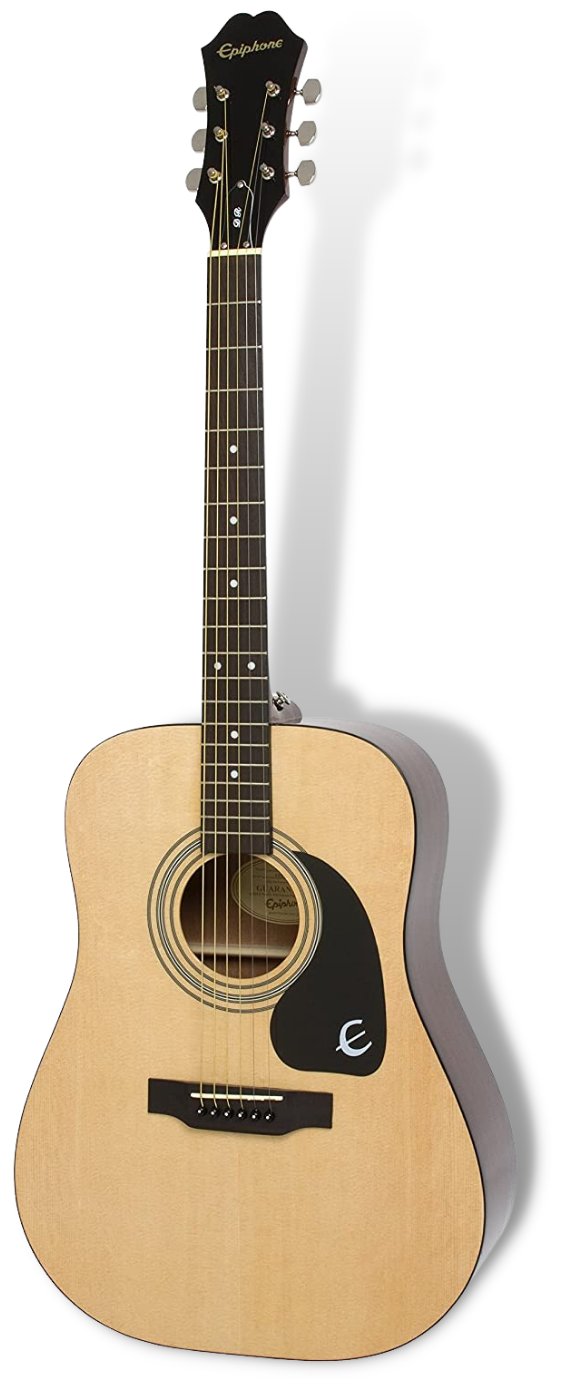
– Tuning Machines
The tuning machines (or “tuners”) are one of the most important parts of the hardware on any guitar.
They’re responsible for holding the strings tight so that they can vibrate properly and produce the correct pitch.
On this Epiphone DR-100 dreadnought acoustic guitar, the tuning machines are simple but effective, they’re made of nickel and have a classic and straightforward design.
- Material: Nickel
- Design: Classic
Bad and low-quality tuning machines can make your guitar go out of tune quickly and be difficult to keep in tune.
They can also make it difficult to change the strings, and make the guitar generally more difficult to play.
Must Remember:
Good tuning machines are made of strong and durable materials and have a precise and smooth action.
You’d want to look for materials such as nickel-plated steel, or stainless steel, which are less likely to rust.
These materials are also less likely to tarnish, so your guitar will look good for longer.
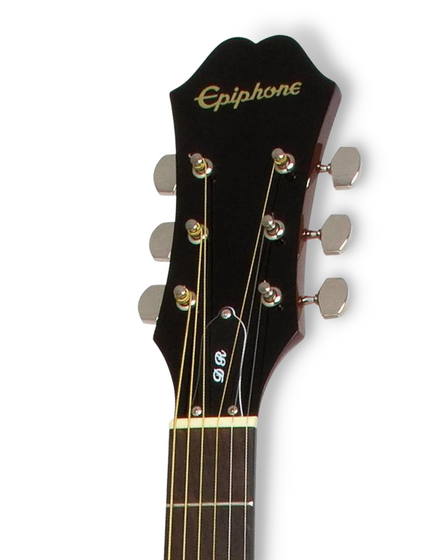
– Pickguard
The pickguard is a small piece of plastic or metal that’s mounted on the body of the guitar, near the strings.
Its purpose is to protect the finish of the guitar from being scratched by the pick as you play.
Most pickguards are made of either plastic or metal, and nowadays maybe even carbon fiber, and there are a few different designs that you’ll come across.
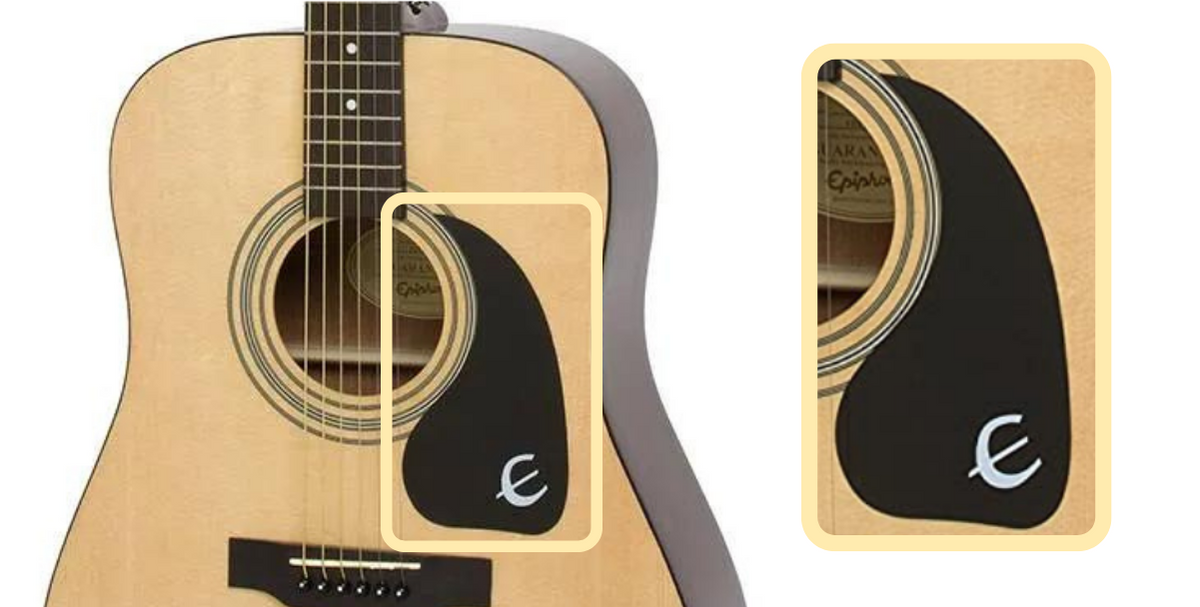
The Epiphone DR-100 Dreadnought has a simple black pickguard with the white “E” logo from Epiphone.
- Color: Black
- Design: White “E” logo
A good guitar pickguard needs to do two things: protect the guitar and look good.
When it comes to protection, a good pickguard needs to be made of a durable material that can withstand regular use.
It also needs to be in a position where it’s not likely to get scratched by the player’s pick.
As for looks, a good pickguard should complement the overall aesthetic of the guitar.
It shouldn’t be too intrusive or stand out too much, but it also shouldn’t be so small or low-quality that it looks out of place.
The Epiphone DR-100 Dreadnought’s pickguard does a good job of both protecting the guitar and looking good.
It’s made of durable plastic that won’t scratch easily, and it has a simple design that doesn’t distract from the rest of the guitar.
– Strap Buttons
Strap buttons are small metal buttons that are mounted on the body of the guitar, and they’re used to attach a strap to the instrument.
Most guitars will have two strap buttons, one on each side of the body.
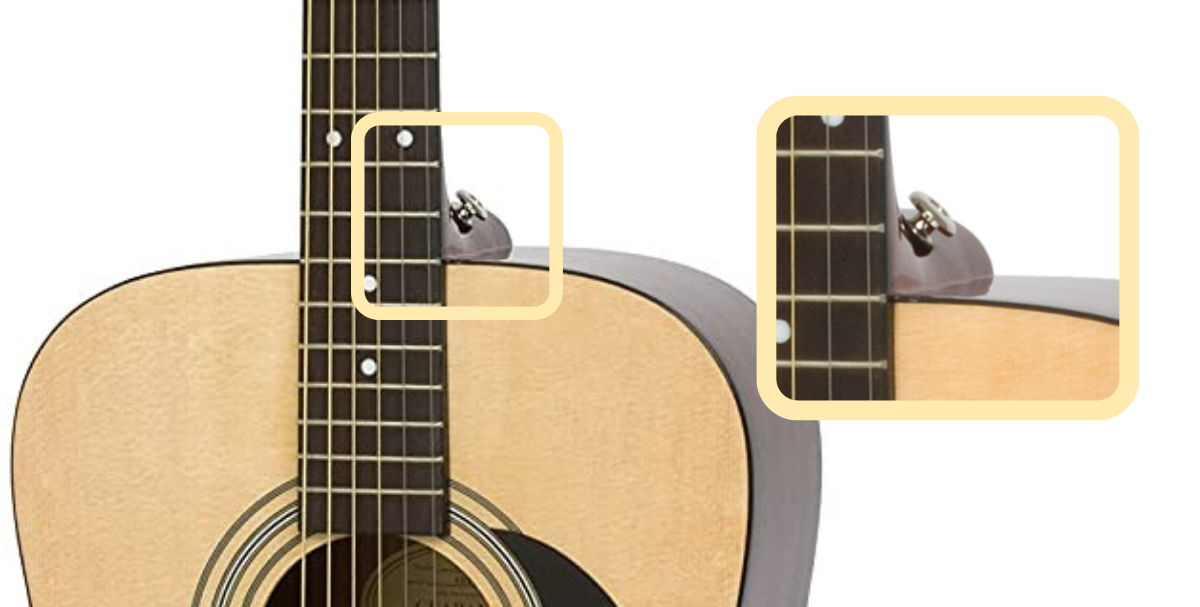
These strap buttons are made of metal, and they should be strong and durable so that they don’t come loose over time.
The Epiphone DR-100 dreadnought acoustic guitar has two strap buttons, both of which are made of metal and seem to be quite durable.
- Material: Steel
- Position: Bottom and side of heel
- Design: Classic
Even though for most people, whether the strap buttons are good or not won’t be a deal-breaker for them, it’s still something to keep in mind.
Body
The body of a guitar is the main part of the instrument, and it’s where the neck, bridge, and strings are attached.
It also has a hole in it (the “soundhole”) which allows sound to resonate from the inside of the instrument.
Most guitars have a wooden body, although there are some with carbon fiber, metal, and plastic bodies (less usual).
– Wood
The type of wood that’s used for the body can affect the sound of the guitar, so that’s something to keep in mind if you’re looking for a particular tone.
When it comes to the Epiphone DR-100, it has a laminated spruce top with a mahogany back and sides.
This combination of woods gives the guitar a very rich and full sound.
– Finish
The body finish is the final layer of protection for the wood of the guitar body.
When it comes to this guitar in specific, you’ll get a Gloss Nitrocellulose Lacquer finish.
It’s what gives the guitar its shine and luster, and it also protects the wood from scratches, dings, and other damage.
There are many different types of finishes that you’ll come across, some of them are:
- Polyurethane
- Nitrocellulose Lacquer
- Polyester
Nitrocellulose Lacquer is considered to be the best type of finish, but it’s also the most expensive.
It’s a durable finish that can be buffed to a high shine, and it’s also relatively easy to repair if it’s damaged.
Polyurethane is a cheaper alternative that’s almost as good, and Polyester is the cheapest option but it doesn’t provide as much protection.
Among these categories, there are subcategories as well, such as:
- Gloss finishes: High shine and they’re very reflective.
- Matte finishes: Have a lower shine and they’re not very reflective.
- Satin finishes: Somewhere in-between gloss and matte, they have a moderate shine and they’re somewhat reflective.
– Colors Available
When it comes to the body of a guitar, the color is not a factor in the overall sound.
However, it can be a factor in the look and feel of the instrument.
Some people prefer a guitar that’s a certain color because it matches their style, or because it’s easier to see in low light conditions.
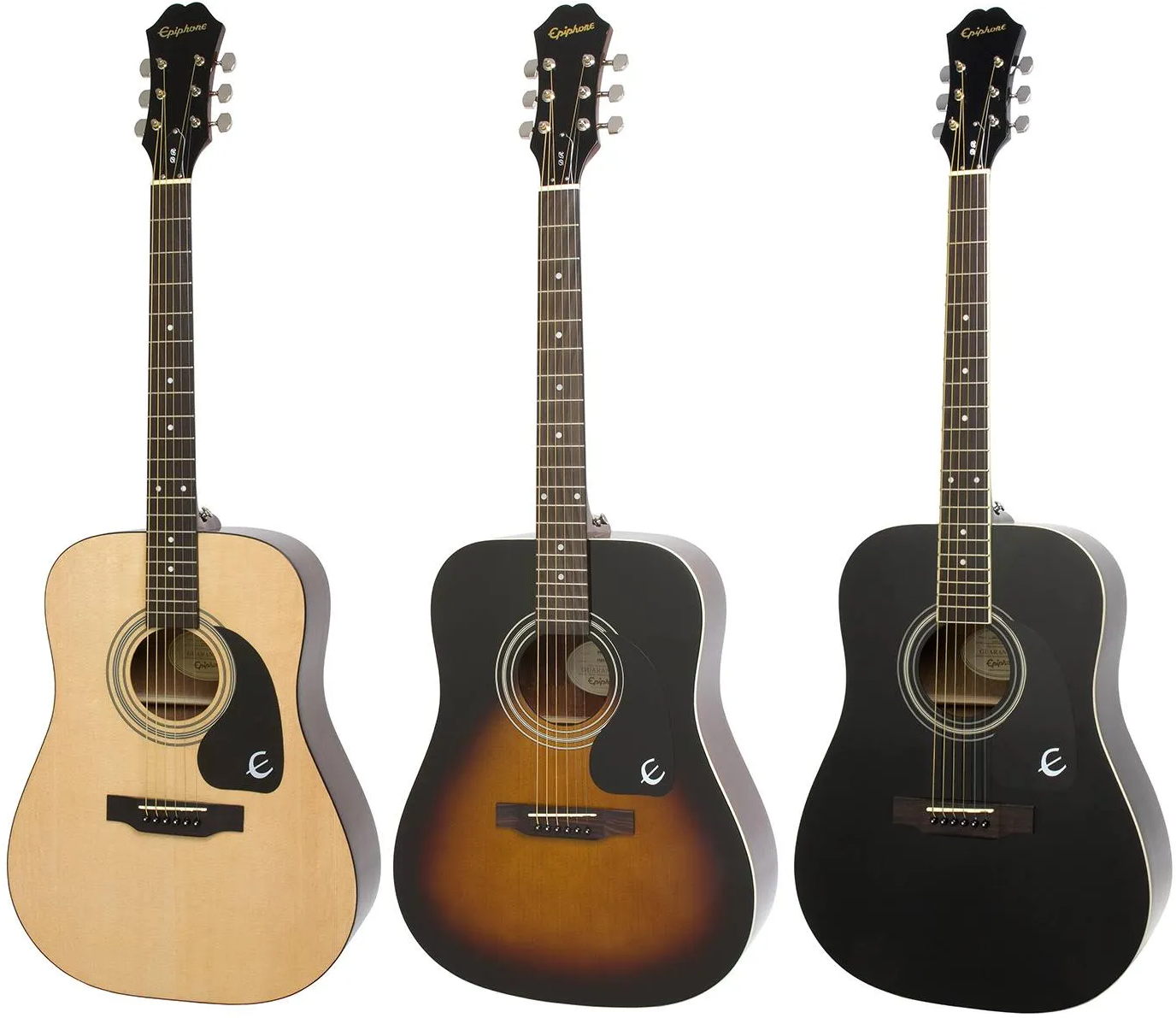
Some of the most popular colors for guitar bodies are:
- Natural: This is the color of wood that hasn’t been stained or painted.
- Black: Black is a popular color for metal-style guitars.
- Sunburst: Sunburst is a combination of light and dark colors, usually red, yellow, and brown.
– Bridge, Saddle, and Pins
Each one of these components plays an important role in how the guitar sounds and feels.
For example, the bridge is responsible for transferring the vibrations of the strings to the body of the guitar.
The saddle is what the strings sit on, and it’s usually made of plastic or bone.
And the pins are what hold the strings in place.

There are many different types of bridges, each with its own advantages and disadvantages.
The DR-100 has a standard pin bridge with black-colored plastic pins and a plastic saddle.
On acoustic guitars, you’ll mainly see three types of bridges:
- Pin bridges (standard)
- Pinless bridges
- Classical bridge
Pin bridges are the most common type of bridge, and they’re also the easiest to replace.
However, they can be a bit more difficult to intonate, which means getting the strings in the correct position.
Pinless bridges are less common, but they’re easier to intonate.
They also have the advantage of not requiring any pins, which can be a pain to keep track of.
Lastly, classical guitar bridges are only used on classical guitars.
They’re similar in shape that most other bridges, but the main difference is that they don’t have any pins and just consist of a saddle and wooden block that has a hole for each string.
Said hole is used to tie the string down, which gives the guitar a much cleaner look.
Now, the type of saddle you choose is also important; plastic saddles are the cheapest and easiest to find, but they don’t last as long as bone saddles.
Bone saddles are more expensive, but they’re also more durable.
As for the bridge pins, there are three main types:
- Plastic bridge pins
- Steel bridge pins
- Brass bridge pins
Plastic bridge pins are the cheapest and easiest to find, but they’re also the least durable.
Steel bridge pins are more expensive, but they’re also more durable.
Brass bridge pins are the most expensive, but they’re also the most durable.
Neck
The neck is the long thin part of the guitar that extends from the body to the headstock.
It’s usually made of wood, but it can also be made of other materials like plastic or even metal.
The type of wood that’s used for the neck can affect the guitar’s playability and sound since different woods have different properties and impact the way that the vibrations produced by the strings behave.
When it comes to the Epiphone DR-100, its neck is made of mahogany, which gives the guitar a warm, rich tone, and has a Slim Taper D-profile that’s very comfortable to play.
The most common type of neck is the bolt-on neck, which is screwed or bolted onto the body of the guitar.
Another popular type is the set-neck, which is glued to the body.
Guitar necks have a few important parts, which include: the fretboard, the frets, the nut, and the truss rod.
Fretboard
The fretboard is the surface on the neck of the guitar where your fingers press down on the strings.
It’s usually made of wood, but it can also be made of other materials like carbon fiber, plastic or even metal.
The Epiphone DR-100 has a rosewood fretboard with Pearloid dot inlays:

Even though this has always been a big debate, it is generally agreed that the type of wood that’s used for the fretboard can slightly affect the sound of the guitar.
For example, maple is a popular choice for electric guitars because it gives the instrument a bright, cutting tone.
Rosewood is another popular choice, and it’s often used on acoustic guitars because it gives the instrument a warm, full-bodied sound.
Ebony is yet another popular choice, and it’s often used on guitars that are meant to have a really clean, clear sound.
There are many different types of fretboards available, each with its own advantages and disadvantages.
The type of fretboard you choose is ultimately up to you and what you’re looking for in a guitar, the tone of the guitar won’t be significantly different, but the feel of the guitar will be.

Brand Info
Epiphone is a musical instrument manufacturer founded in 1873 by Anastasios Stathopoulos.
The company started out as a family-based business in Greece before eventually moving to the United States.
It’s credited with being one of the first companies to mass-produce electric guitars, and they continue to be a leading manufacturer of both acoustic and electric instruments.
At the same time, they’re known for their quality craftsmanship and attention to detail, making them a popular choice for both professional and amateur musicians alike.
Their guitars are high quality and affordable, and they’re a great choice for beginners and experienced players alike.
One of the things that makes Epiphone so special is their wide range of different models, so no matter what type of guitar you’re looking for, Epiphone has a model that’s perfect for you.

Videos
For those of you who want to get a more in-depth look at this guitar, we’ve included some videos below.
The first video is a demo showing off how it sounds and looks.
While the second video is a review that goes over some of its features and specs.
Demo
Review
Specifications
A guitar’s specifications can tell you a lot about the instrument, and they can be helpful when you’re trying to decide between different models.
Below, we’ve included the specifications for the Epiphone DR-100:
– General
| Brand | Epiphone |
| Model | DR-100 |
| Type | Acoustic |
| Size | Full Size |
| Colors | Natural, sunburst, and black |
| Number of Strings | 6 |
| Hardware Plating | Chrome |
| Tuning Machines | Premium die cast |
| Electro-acoustic | No |
| Built-in Tuner | Not applicable |
– Body
| Body Style | Dreadnought |
| Cutaway | No |
| Solid Top | No |
| Top Material | Laminated Spruce |
| Back Material | Mahogany |
| Sides Material | Mahogany |
| Finish Type | Gloss Nitrocellulose Lacquer |
| Pickguard | Yes |
| Pickguard Design | Black with white “E” logo |
| Strap Buttons | Yes |
| Strap Buttons Position | Bottom and side of heel |
| Strap Buttons Design | Classic |
– Neck
| Neck Material | Mahogany |
| Neck Shape | Slim Taper |
| Scale Length | 25.5″ |
| Truss Rod | 2-way adjustable |
– Fretboard
| Fretboard Material | Rosewood |
| Fingerboard Inlay | Pearloid Dots |
| Number of Frets | 20 |
– Bridge, nut, saddle, pins
| Bridge Design | Standard pin bridges |
| Pin Color | Black |
| Pin Material | Plastic |
| Bridge Material | Rosewood |
| Saddle Material | Plastic |
| Nut Material | Synthetic |
| Nut Width | 1.68″ |
Please note that some brands might change the type of materials that they use on their guitars.
This can be because of new regulations and laws that come and go throughout the years.
If you see a mistake in any of these specifications, please let us know and we’ll correct it.
You can reach out to us via our email: [email protected]
I also encourage you to check out our other guitar reviews if you’re looking for something specific that you might have not found here with this guitar.
There are a lot of great guitars out there, and it can be tough to choose the right one sometimes.
We have reviews on electric guitars, acoustic guitars, bass guitars, effects pedals, and more.
No matter what your budget is, or what type of guitar you’re looking for, we should be able to help you find the perfect one for you.

Born and raised in Florida! I’ve been playing guitars for the past 5 years. Love to learn, and I’m always striving to achieve greater heights in music. Currently have a Fender Stratocaster as my main guitar.

